Physical Address
304 North Cardinal St.
Dorchester Center, MA 02124
Peripheral neuroblastic tumors arising from the sympathoadrenal lineage of neural crest during development include neuroblastoma, ganglioneuroblastoma, and ganglioneuroma. Although some ganglioneuromas were once believed to arise independently of neuroblastoma, the International Neuroblastoma Pathology Committee now states that “all ganglioneuromas were once neuroblastomas at an early time in their development.”
Much has been discovered regarding the genetic and transcriptional regulation of neural crest development, but the events leading to “neuroblastoma” tumorigenesis, either genetic or epigenetic, remain poorly understood. Because of the early onset of this disease in infants and children, or even prenatally, a role for preconceptual or gestational factors has been suggested. However, no definite factors consistently increasing the incidence of peripheral neuroblastic tumors have been identified to date. From 1% to 2% of affected individuals have a familial history of this disease. Familial neuroblastoma seems to have an autosomal dominant inheritance pattern with incomplete penetration. Genome-wide study has identified a linkage of familial neuroblastoma to 16q12-13. Germline mutations observed in patients with familial neuroblastoma include PHOX2B (paired-like homeobox 2b) and ALK (anaplastic lymphoma kinase). PHOX2B mutation, the first genetic event identified to predispose to neuroblastoma, has been detected in a small number of inherited cases. PHOX2B encodes a homeodomain transcription factor promoting cell cycle exit and neuronal differentiation and plays a crucial role in the development of neural crest–derived autonomic neurons. However, ALK mutations, causing constitutive phosphorylation of ALK and leading to dysregulation of cell signaling and then uncontrolled proliferation of neuroblastic cells, seem to account for most hereditary cases of neuroblastoma. ALK activating mutations or amplifications are also observed in sporadic cases.
Neuroblastoma tends to be less common in blacks than whites. In certain parts of the world, notably the Burkitt lymphoma belt in Africa, it is practically nonexistent. “In situ neuroblastomas,” microscopic foci of “neuroblastoma” confined to the adrenal or periadrenal location, are discovered incidentally at autopsy. The incidence of in situ neuroblastoma is much higher (1 to 200 infants dying of other causes) than clinically detectable neuroblastoma. The neoplastic nature or clonality of in situ neuroblastoma remains to be proved.
Peripheral neuroblastic tumors, the most common extracranial solid tumors in children, are the third most common childhood neoplasm after leukemias and brain tumors. They are also the most common neoplasms during the first year of life; about 40% of cases are diagnosed in infants, and some are detected prenatally by ultrasound examination. The prevalence of this disease in the United States is 1 per 7000 live births, and 650 to 700 newly diagnosed cases are encountered per year. Almost 90% are diagnosed before 5 years of age; the median age at diagnosis is 17.3 months. The disease is slightly more common in males (1.2:1).
The primary sites follow the migration pattern of neural crest cells during embryonal life and include the adrenal gland (40%) and the abdominal (25%), thoracic (15%), pelvic (5%), and cervical (3%–5%) sympathetic ganglia. About 1% of patients have no detectable primary tumor. Tumors in this group show both lymphatic and hematogenous spread, with more than half the cases presenting with metastasis at diagnosis to the lymph nodes, bone marrow, bone, liver, and/or skin/subcutaneous tissue. It is rare to see lung metastasis at diagnosis of this disease. Central nervous system (CNS) involvement, when present, often shows a pattern of diffuse spread along the meningeal surfaces.
The clinical symptoms of this disease are caused by the growth of the main tumor mass and by metastatic spread. Retroperitoneal/abdominal masses present with abdominal distention and constipation; mediastinal masses cause respiratory distress; and paraspinal dumbbell-shaped tumors with intraspinal and extradural extension present with serious neurologic symptoms. Signs of metastatic disease include lymphadenopathy, hepatomegaly, bone pain, and raccoon eyes (exophthalmia associated with distinct bruising and swelling around the eyes).
Several paraneoplastic syndromes associated with neuroblastomas have been reported and include the following:
Verner-Morrison syndrome : intractable secretory diarrhea caused by vasoactive intestinal peptide (VIP) secretion by tumors often composed of differentiating neuroblasts, observed in 4% of cases
Opsoclonus-myoclonus-ataxia syndrome : rapid, random eye movement (dancing eyes) and acute cerebellar ataxia in children 1 to 3 years of age, with tumors characteristically having extensive lymphocytic infiltration and lymphoid follicular formations, suggesting an autoimmune mechanism, observed in 2% to 3% of cases
Hypertension : caused by catecholamine secretion or renal artery compression by tumors, observed in 2% to 3% of cases
Horner syndrome : unilateral ptosis, myosis, and anhidrosis associated with cervical tumors, observed in 2.4% of cases
Rare cases with constitutional PHOX2B mutations have also been reported; non–polyalanine repeat expansion mutations of PHOX2B are associated with a syndrome constituting neuroblastoma, Hirschsprung disease, and congenital central hypoventilation (primary alveolar hypoventilation, Ondine curse). Other associated conditions include myasthenia gravis, Cushing syndrome, neurofibromatosis type 1, and fetal hydantoin syndrome. In neuroblastoma survivors, development of renal cell carcinomas has been reported; such tumors most likely represent a heterogeneous group of tumors rather than a unique disease entity.
Retroperitoneal neuroblastomas may show anterior, lateral, and/or downward displacement of the kidney secondary to mass effect. They also can show direct infiltration into the kidney parenchyma, especially in tumors with MYCN oncogene amplification. Calcification in the tumor tissue is a characteristic finding. Metastatic bony lesions often found in the skull, femur, and humerus are osteolytic; occasionally they are bilaterally symmetric in distribution. Imaging studies for this disease include bone scan (technetium 99m), computed tomography (CT) scan, and positron emission tomography (PET) scan. MIBG (meta-iodobenzylguanidine) scan, which is taken up by secretory granules of the tumor cells and avid in 90% to 95% of all tumors, is useful for the diagnosis and monitoring of tumor response during the clinical course ( 123 I-MIBG) and is also used as an effective therapeutic agent ( 131 I-MIBG).
Vanillylmandelic acid (VMA) and homovanillic acid (HVA) are well-known catecholamine metabolites useful for neuroblastoma diagnosis. Retrospective studies have shown that when all eight urinary catecholamine metabolites (VMA, HVA, 3-methoxytyramine [3MT], dopamine, epinephrine, metanephrine, norepinephrine, normetanephrine [NMN]) were tested in combination, a diagnostic sensitivity of 95% was achieved for this disease. Measurement of these markers is also useful for monitoring of disease activity. Reports indicate that elevated levels of serum neuron-specific enolase (NSE, >100 ng/mL), ferritin (>150 ng/mL), and lactic dehydrogenase (LDH, >1500 IU/L) and VMA/HVA ratio less than 1.0 indicate a poor prognosis. Detection of circulating MYCN in serum DNA may be useful in predicting prognosis in neuroblastoma patients.
The International Neuroblastoma Pathology Committee (INPC) defines four categories in peripheral neuroblastic tumors : neuroblastoma ( schwannian stroma-poor ); ganglioneuroblastoma, intermixed ( schwannian stroma-rich ); ganglioneuroma ( schwannian stroma-dominant ); and ganglioneuroblastoma, nodular ( composite, schwannian stroma-rich/stroma-dominant and stroma-poor ). The degree of schwannian stromal cell development is noted in parentheses after the individual tumor category. The first three categories represent the maturation sequences promoted by the “cross-talk” between neuroblastic tumor cells and the schwannian stromal cells of this disease. This cross-talk is supported by various pathways, including NGF/TrkA signaling and Nrg1/ErbB signaling between tumor and schwannian stromal cells. The last category (nodular ganglioneuroblastoma) is a composite tumor composed of distinct histologies (clones).
Tumors in this category form a soft, yellowish gray-tan mass, and often have foci of calcification. Cystic change may be seen. The tumor mass can be well encapsulated or can show invasive growth into the surrounding tissue. Histologically, these neuroblastomas (schwannian stroma-poor) are composed of neuroblastic cells of various stages of differentiation. The tumor cells form groups or nests demarcated by thin, fibrovascular stromal septa where no or limited schwannian cells are detected. Three subtypes are recognized in this category: undifferentiated, poorly differentiated, and differentiating. The first two subtypes are often hemorrhagic with or without foci of necrosis ( Fig. 28.1A ), whereas the last subtype is less often hemorrhagic ( Fig. 28.1B ).
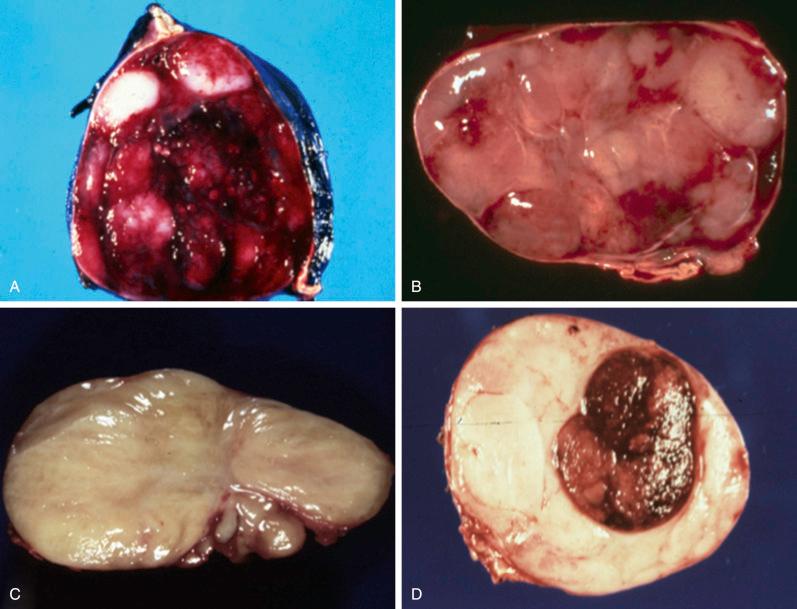
Neuroblastoma, undifferentiated subtype is rare and requires supplementary techniques such as immunohistochemistry (IHC), electron microscopy, and/or molecular tests to establish the diagnosis, since the proliferating cells have a uniformly primitive appearance without clearly recognizable neurite production ( Fig. 28.2 ).
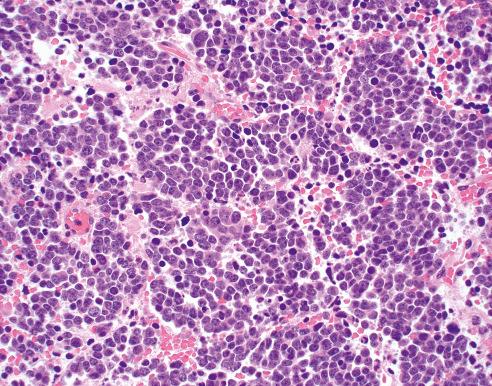
Neuroblastoma, poorly differentiated subtype is the most common subtype and is characterized by the presence of readily recognizable neurites produced by the tumor cells with or without associated Homer Wright rosettes ( Fig. 28.3 ). By definition, less than 5% of the neuroblastic cells have cytomorphologic features of differentiation (see differentiating subtype). The nuclear morphology of the neuroblastic cells in this subtype is often described as having a “salt-and-pepper” appearance ( Fig.28.4 ). However, careful microscopic examination discloses that approximately 30% of the tumors are composed of cells having one to a few prominent nucleoli (nucleolar hypertrophy), especially when MYCN oncogene is amplified ( Fig. 28.5 ). Tumors of the undifferentiated and poorly differentiated subtypes may also show unusual histologic features (e.g., pleomorphism, fusiform or spindled cells, pseudorhabdoid cells) focally or diffusely. Rare undifferentiated and poorly differentiated neuroblastomas contain cells with an enlarged and characteristically open nucleus containing one to a few prominent nucleoli ( large cell neuroblastoma ) ( Fig. 28.6 ).

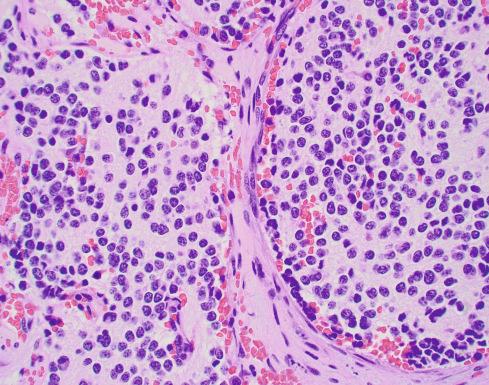
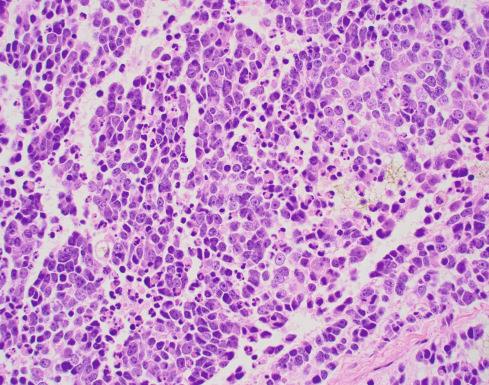
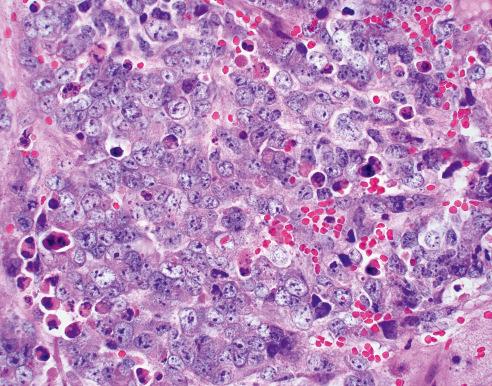
Neuroblastoma, differentiating subtype is a tumor with usually abundant neurite formation, and more than 5% of tumor cells have the appearance of differentiating neuroblasts ( Fig. 28.7 ). A differentiating neuroblast is defined by synchronous differentiation of the nucleus (enlarged, often eccentrically located, with a vesicular chromatin pattern and usually a single prominent nucleolus) and the cytoplasm (eosinophilic/amphophilic, with a diameter ≥2 times that of the nucleus). Those differentiating neuroblasts may contain Nissl bodies in the periphery of their cytoplasm.
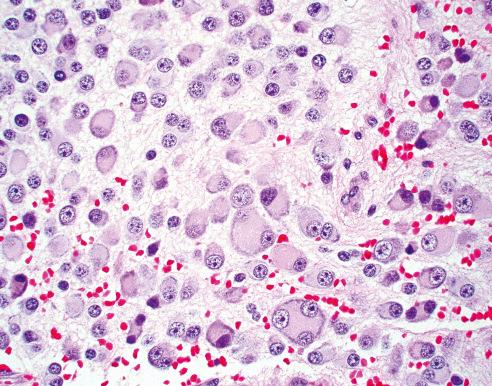
This category includes tumors containing microscopic nests of neuroblastic cells intermixed or randomly distributed in the ganglioneuromatous tissue ( Fig. 28.8 ) (see Ganglioneuroma, next). These nests are composed of a mixture of neuroblastic cells in various stages of differentiation, usually dominated by differentiating neuroblasts, in a background of clearly visible neurites. In other words, the neurites produced by the neuroblastic cells in these nests are still “naked” and not incorporated by the schwannian stromal cells. By definition, more than 50% of the tumor tissue shows a ganglioneuromatous appearance, with ganglion cells embedded in abundant schwannian stroma.
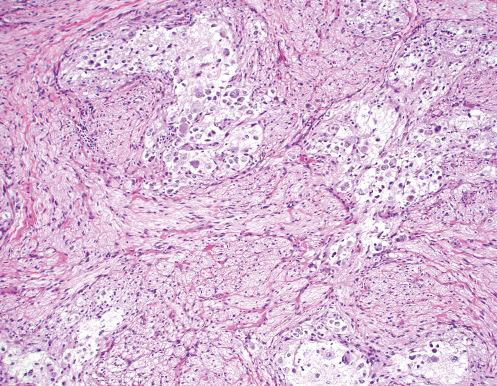
Tumors in this category are characterized by the presence of ganglion cells individually distributed in schwannian stroma. In this stage of maturation, neuritic processes produced by those ganglion cells are immediately incorporated in the cytoplasm of schwannian stromal cells, so that there are no microscopic foci of naked neuropil without schwannian coverage ( Fig. 28.9 ). Two subtypes, maturing and mature, are included in this category. The maturing subtype has both maturing and mature ganglion cells, and the mature subtype has exclusively mature ganglion cells embedded in the schwannian stroma. The mature ganglion cells are always surrounded by satellite cells. The stromal tissue is usually well organized and shows a fascicular profile of neuritic processes accompanied by Schwann cells and perineurial cells.
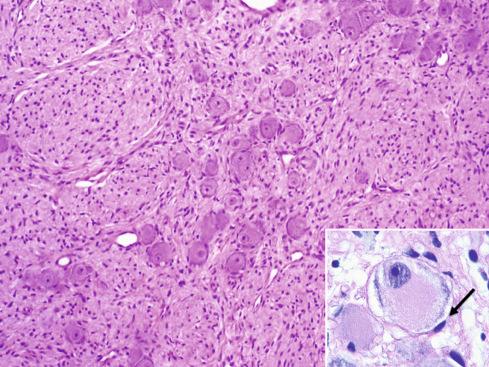
Because of the schwannian stromal development, ganglioneuroblastoma, intermixed (schwannian stroma-rich) and ganglioneuroma (schwannian stroma-dominant) have a firmer, more elastic consistency and yellowish, tan-white cut surfaces ( Fig. 28.1C ). The free surfaces of these tumors are well encapsulated. However, they can show infiltrative growth into surrounding retroperitoneal fatty tissue. Paraspinal tumors often adhere firmly to the vertebral bodies, and thus a clean surgical resection is not feasible. The presence of residual tumor tissue of ganglioneuroblastoma, intermixed and ganglioneuroma after gross surgical resection would usually not affect the favorable clinical outcome.
Tumors in this category are characterized by the presence of grossly visible, usually hemorrhagic and/or necrotic nodule(s) of neuroblastoma (schwannian stroma-poor) component, coexisting with a ganglioneuroblastoma, intermixed (schwannian stroma-rich) component or with a ganglioneuroma (schwannian stroma-dominant) component ( Figs. 28.1D and 28.10 ]. The term composite implies that the tumor is composed of biologically different clones.
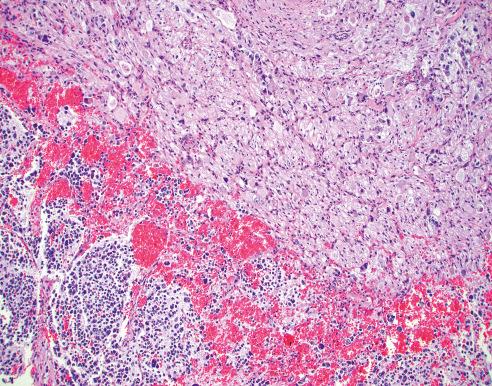
The tumor cells in nodular ganglioneuroblastoma are immunohistochemically positive for neuronal markers, including NSE, synaptophysin, chromogranin A, protein gene product 9.5 (PGP9.5), CD56, and neurofilament protein. These markers are also positive for all tumors whose neoplastic cells have neuronal phenotype, and they are not specific for the diagnosis of neuroblastoma. Neuroblastoma cells are also positive with the NB84 antibody, recognizing a 57-kDa unknown antigen. This is a sensitive but nonspecific marker of neuroblastoma. Because of their cellular origin, neuroblastomas are positive for neural crest markers, such as tyrosine hydroxylase (TH) and PHOX2B. Of these, PHOX2B is more stable and sensitive for neuroblastoma diagnosis than TH, which is negative in some undifferentiated neuroblastomas and is also sensitive to decalcification. Both TH and PHOX2B are also positive in pheochromocytoma. S-100 protein is expressed by mature schwannian stromal cells in ganglioneuroblastoma, intermixed and ganglioneuroma. In some neuroblastomas, S-100 protein can also stain putative Schwann cells (“schwannian blasts”) in the thin fibrovascular septa demarcating groups/nests of neuroblasts.
Become a Clinical Tree membership for Full access and enjoy Unlimited articles
If you are a member. Log in here